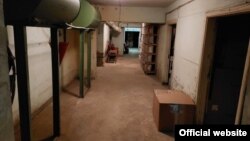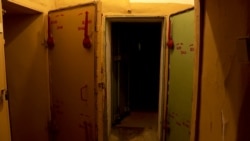KYIV -- Finding protection from an air raid or artillery bombardment might prove difficult for residents of Kherson, a vital port city where the Dnieper River flows into the Black Sea in southern Ukraine.
With a buildup of what Ukraine's defense minister says are some 140,000 Russian troops near the borders stoking fears of a new Russian invasion, cities across the country of 44 million are inspecting their bomb shelters, or at least notifying residents where the Cold War-era refuges are located.
In Kherson, 545 kilometers south of Kyiv, a city council report published earlier this month said that the majority of the 139 bomb shelters had been converted to places of business, from barber shops to tattoo parlors. Some others, after decades of neglect, are too dilapidated to be used.
Adding to the urgency in Kherson is the city's proximity to the Russian-occupied Crimean Peninsula, 150 kilometers to the south, where Ukrainian intelligence officials have said Moscow has a permanent military force of 33,000 troops buttressed by sophisticated naval, ground, and air weaponry. The port city would be a target should Russia seek to seize territory stretching from its border with Ukraine to Crimea, which is now linked to Russia by a single bridge.
According to Oleh Holovatiy, chief specialist of the Kherson city council's civil-defense department, "many shelters are in poor condition."
Part of the reason, officials say, is that only 17 of the shelters in the city of 280,000 are owned by the state. The rest belong to condominium associations or are privately owned, though in some cases there is no listed owner in city records.
"Therefore, we urge citizens to demand from the heads of condominiums or service companies to work on the installation of such shelters in basements," Holovaty said, according to the city council's press service.
One shelter, underneath the Naddnipryanska Pravda publishing house, was found to have groundwater seeping in. Others have limited access or simply are locked, he added. "Therefore, if we are talking about the issue of sheltering the civilian population, we must focus on bringing to readiness the simplest of shelters -- that is, basements," Holovatiy said.
Most of the refuges that are accessible and adequately equipped are city-owned. One, at a local hospital, can accommodate up to 300 people and boasts a water supply with 300-liter water tanks, a sewage system, as well as air-supply lines, a generator, and an emergency exit.
Most basement shelters, however, are only usable for one to four hours.
Should war reach Ukraine's residents beyond the ongoing conflict in eastern Ukraine, where fighting between the government and Russian-led forces who hold parts of two provinces has killed more than 13,000 people since April 2014, a civil-defense alarm will sound. That is the signal for citizens to turn on the radio or television for further instructions, according to a booklet titled In Case Of An Emergency Or War, published in June 2021 by the Culture Ministry and the Information Policy Ministry.
People heading to shelters should take identification documents, water, money, medicines, and essential goods with them, it says.
Nationwide, official data indicate that just 11 percent of the 21,000 shelters are operational, according to a December report by Current Time, a Russian-language network run by RFE/RL in cooperation with VOA.
Larger cities like Kyiv and Kharkiv, the second-biggest in Ukraine, have more underground passages and parking lots that offer safety, including subway systems that can be used as bomb shelters.
The Kharkiv region, whose capital lies 40 kilometers from the Russian border and was recently named as a potential Russian target by Ukrainian President Volodymyr Zelenskiy, released an audit of its shelters in January. About 80 percent of 300 shelters and 4,000 basements are ready for use, Ivan Sokol, director of the region's Civil Defense Department, told a local media outlet. An online, interactive map of bomb shelters for the city's 1.4 million residents was created by the local unit of the state emergencies service.
In Kyiv, officials have said that 19 percent of approximately 4,500 underground locations are not ready for use. As in Kherson, reports found many basements not usable or converted to commercial business space, including a strip club.
Multiple media reports have cited the owner of the club, which is located near a major stadium in central Kyiv, as promising to let people in if the city comes under attack.
A member of parliament who lives nearby, Lesya Vasylenko, joked on Twitter that she hoped bouncers controlling entry to the club "won't be too strict in case of [an] emergency."












